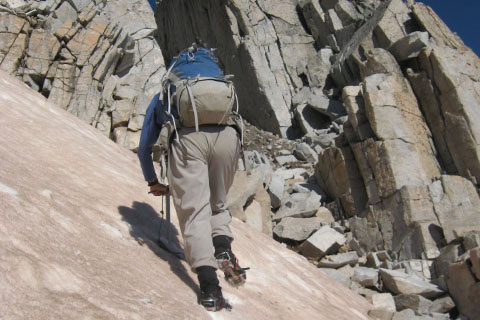| 382 | BD Raven Pro Ice Axe | 2011-04-27 |

When getting ready for any hike, anywhere, unless you are following some kind of masochistic training regime, the lighter the pack the better. So a 19 pound pack is more comfortable than a 20 pound pack and a 9 pound pack is more comfortable than a 10 pound pack. The trick is, to pack what you need and to leave behind the things you don't need.
In the summer of '09 when we were climbing the 54 Colorado Fourteeners we were always looking for ways to lighten our loads. Each night we packed with care for the next day's climb. Each night we mentally weighed each item and made crucial decisions that would impact our safety and ease of travel. During the packing events, we would discuss the conditions we expected to encounter and the gear we would need. Did we really need gaiters? Could we get by with wearing running shoes instead of boots? Were we going to carry a water filter or not, etc. A key discussion every night was ice axes.
The summer of '09 was a snowy summer. The snow lingered to the end of July. We would have had better conditions if we had waited until August before starting our quest; but that was not when we had vacation. When we were packing for each climb, we kept asking each other, do you think we really need ice axes? Most light axes weigh about a pound and packing an ice axe would be adding that weight to our packs. Instead of nineteen pounds, the pack would weigh twenty pounds. Should we carry the axe?
We at times didn't carry axes; but then, inevitably we needed them. We always regretted our weight saving efforts. Trekking poles are not a substitute for an ice axe.
So our advice is: if you going to the mountains, train to be strong enough to always carry an ice axe. If you don't need it, you will still look good carrying it on your pack. Ha!
If you are going to carry an axe, carry a light one. We recommend the Black Diamond Raven Pro. It is a very good snow craft ice axe. Mine is three or four years old and has performed flawlessly.
A few ice axe tips ...
If you are going to carry an axe, learn how to use it.
Learn to attach the ice axe to your pack and how to carry the axe while walking with it in your hand.
Remember, the sharper the points of the axe - the easier the points can penetrate the snow and your skin.
The axe is a tool with 1001 uses. Naturally it is made to use on the snow; but it is also a useful faid while scrambling on rock. Other uses include a tent stake, a walking cane, a splint for an injured limb, a short pole for a tarp, an aide while hanging or retrieving bear bags, lantern holder, etc
Learning to self arrest (stopping yourself from a sliding fall on snow) is important; but it is more important to learn to self belay yourself with the ice axe. The key is to stop yourself before you fall.
A lightweight axe is still often times heavy. It is all relative.
Sales personnel often disagree on what size of axe to buy. If a sales person is pressuring you into buying one size of axe, ask to see another size, just to make sure they have both sizes! Generally, if you are a small person, the 60 cm might be long enough and if you are larger, the 70 cm will probably work. A good rule of thumb is when holding the axe diagonally from your shoulder toward your waist on the opposite side, do you have enough room to grab the end of the shaft? This is essentially the position you are in when you self arrest. If the axe isn't long enough to clear your body, a self arrest is difficult.
If you are planning on doing technical ice climbing, then buy a technical axe.
Be careful, an axe is not a toy. I have scars!
Happy snowy trails